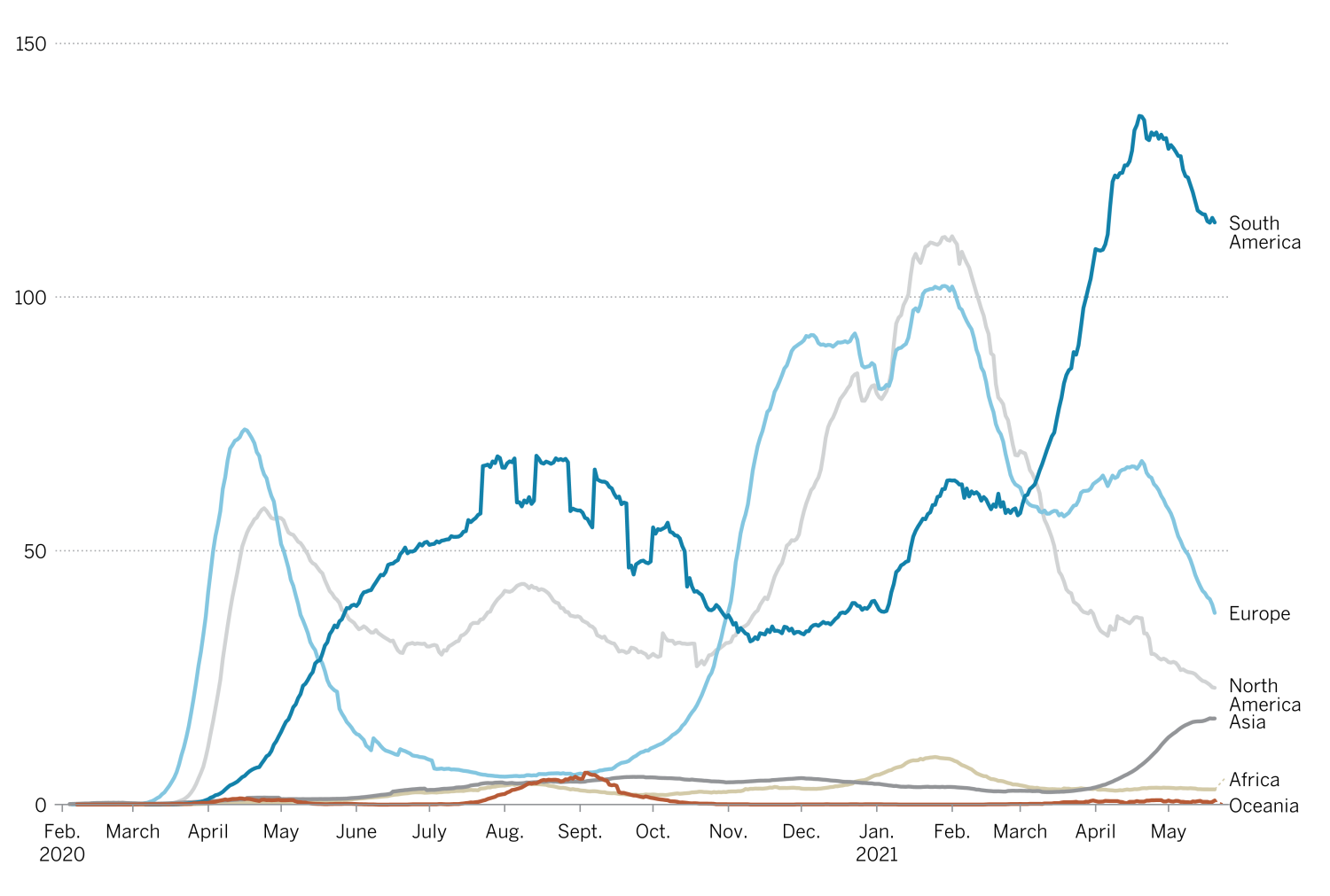The COVID-19 pandemic in five graphs

[ad_1]

COVID-19 deaths worldwide are on the decline.
But that good news obscures some stark geographic differences. While some parts of the world appear to be on the brink of normalcy, a few are experiencing their worst suffering yet.
We’re going to walk you through the pandemic in five graphs, starting with this plot comparing various regions:
Check out South America’s death rate over the past four weeks and how much higher it is than any other continent. Lots of factors might explain the differences, including the age and health of each population, vaccination rates, lockdown policies, the quality of medical care and — experts cautioned — widespread variation in how death statistics are collected.
“South America’s in a bad place. Why exactly? Good question,” said Harvard epidemiologist William Hanage. “I’ll be honest: We don’t know.”
He and other experts said one very likely factor is the P.1 variant, which was first identified in Brazil in December but now circulates widely. It appears to spread more easily and quickly than some other strains.
Meanwhile, the death rate in Africa has been relatively low throughout the pandemic. Some epidemiologists speculated that the continent has been spared by its young population. Others have pointed to limited testing, suggesting that many deaths have gone uncounted.
One thing most can agree on: Nations accustomed to massive disease outbreaks have been more proactive than countries such as the United States when it comes to lockdowns and other control measures. Sierra Leone and Liberia, both ravaged by the Ebola epidemic of 2014-2016, have each reported fewer than 100 COVID-19 deaths.
Now take a look at this plot showing how individual countries have fared — both lately and over the entire course of the pandemic:
Each dot is a nation — the name appears when you hover over it. The higher a country appears on the graph, the higher its death rate over the last four weeks. The further it appears to the right, the higher its total death rate.
With the caveat that death reporting varies, no country appears to have suffered more than Uruguay.
The highest total death rate belongs to Hungary, which brings us to another point: Eastern Europe has been hit very hard.
Here’s a graph comparing it to Western Europe:
Notice that in the early days of the pandemic, the death rate in Western Europe was far higher — it’s hard to forget the tragic scenes from Italy and Spain back then.
But about two months ago, the data show, Eastern Europe caught up to Western Europe and then began pulling away from it. No other region has a higher recorded death rate over the course of the pandemic.
As for the why, some experts think it might have been Eastern Europe’s early success that led to its downfall. Much of the region adopted strict lockdown policies last spring. Then, when a new wave arrived, Eastern Europe was far slower to return to those measures.
In the long term, the most promising option for minimizing deaths and eventually ending the pandemic is wide-scale vaccination.
There are some stark regional differences:
North America and Europe are well ahead of the rest of the world, while Asia and Africa are seriously lagging.
How much is vaccination helping right now?
Some cases are pretty clear. Israel’s campaign to inoculate quickly and widely is “a mind-blowing example of what vaccines can do,” said Dr. Carlos del Rio, an infectious disease expert at Emory University School of Medicine.
At the same time, experts are reluctant to credit vaccines alone for the low COVID-19 death rates in the United States and Western Europe. Many factors contributed to the springtime calm, including the absence of major holidays that are synonymous with large gatherings.
It’s “way, way too early” to say whether higher vaccination rates will consistently lead to lower death rates across the world, Del Rio said.
And remember Uruguay and Hungary and their high death rates? Both countries have relatively high vaccination rates, stumping the experts.
The longer the pandemic persists, the greater the chance that new faster-spreading variants arise — such as the one ravaging India.
Take a look at the accelerating death rate:
As bad as the graph looks, experts doubt that the reported death rate — still lower than in several other countries — is accurately capturing what’s happening on the ground.
Too little testing is being conducted, especially in rural areas, and the scenes of overflowing hospitals and crematorium grounds suggest the country is “massively undercounting cases and deaths,” Hanage said.
How did the country become the epicenter of the pandemic?
Hanage said it is possible that for many months the virus was silently spreading among the massive numbers of young people — a “tinderbox” of asymptomatic infections that eventually moved into more vulnerable segments of the population and exploded.
A shortage of medical oxygen made things worse once the new variant took hold.
“There will be PhDs written one day about what really happened in India,” Hanage said. “There’s substantial lag in the reporting, but there’s also a point at which the system just can’t count anymore. You can almost tell just by doing the math in your head.”
It’s worth remembering that six months ago, the country appeared to be a COVID-19 success story. The catastrophe today shows just how unpredictable the virus can be.
“We can evaluate things as they are now, and make judgments,” Del Rio said. “But even when I see nice numbers like the ones in the U.S., I think to myself: I hope it stays that way.”
[ad_2]
Source link
